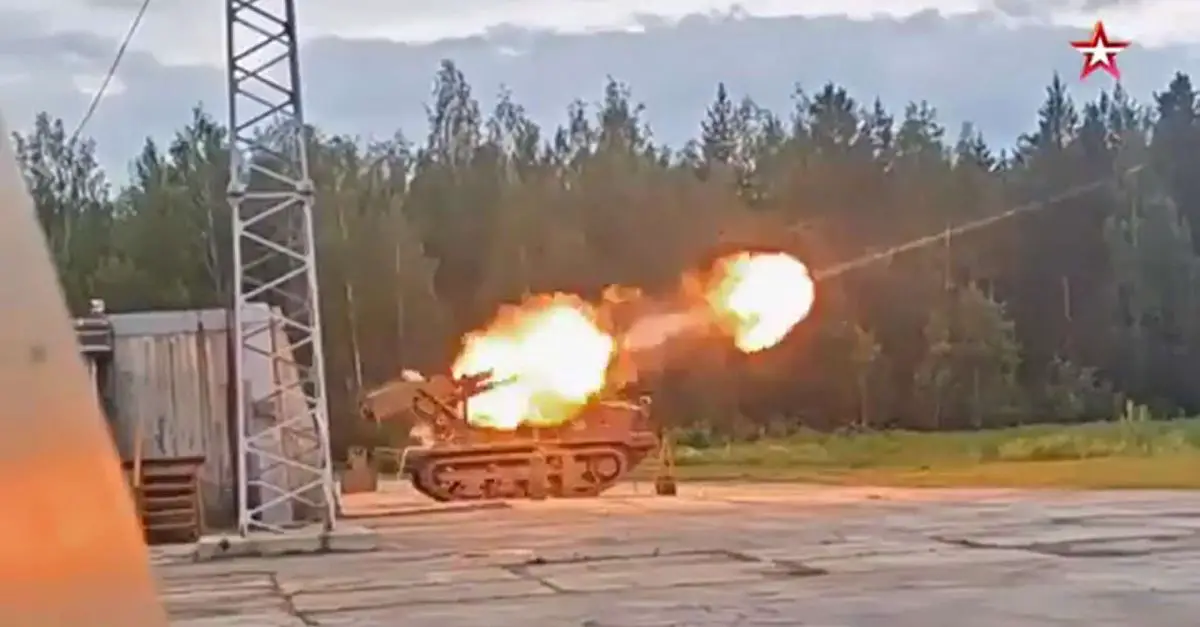Breaking News
Russia tests new unmanned MTS-15 Klever 122 mm self-propelled howitzer ahead of full-scale deployment in Ukraine.
On August 25, 2024, the Russian Defense Ministry released the first video footage of the MTS-15 Klever, an unmanned ground vehicle (UGV) designed as a 122mm tracked self-propelled howitzer. This footage marks the first public demonstration of the MTS-15 Klever, which is scheduled for deployment in Ukraine for full-scale testing under combat conditions. This deployment is anticipated to take place soon, providing an opportunity to evaluate the system's capabilities in a real-world combat condition.
Follow Army Recognition on Google News at this link

One of the key features of the MTS-15 Klever is its automatic loader, capable of firing four shots in quick succession, enabling the system to transition to and from combat positions in approximately 30 seconds. (Picture source: Russian MoD)
The D-30 howitzer, the central component of the MTS-15 Klever, has a long history. Developed in the late 1950s to replace the older M-30 howitzer, the D-30 was introduced into service in the early 1960s. It became a standard artillery piece for Soviet and Warsaw Pact military forces, known for its three-leg mounting system that allows for 360-degree traverse. This design offered stability and flexibility, making it a widely used artillery piece in various conflicts, including the Iran-Iraq War, the Afghan-Soviet War, and the Syrian Civil War. The D-30's operational reliability and adaptability to different combat environments and platforms have contributed to its continued use by many nations today, such as Ethiopia.
The MTS-15 Klever builds on the D-30's legacy by integrating modern technology with this established artillery platform. The unmanned system can be remotely controlled from a distance of up to 500 meters, allowing for operation in potentially dangerous environments. The prototype has already undergone testing at a proving ground and is now set to demonstrate its performance in combat. The Klever has a top speed of 12 kilometers per hour and a cruising range claimed by developers to be 400 kilometers, though other sources suggest it may be closer to 120 kilometers.
One of the key features of the MTS-15 Klever is its automatic loader, capable of firing four shots in quick succession. This automation enables the system to transition to and from combat positions in approximately 30 seconds. Despite these autonomous features, human intervention remains necessary for making adjustments after each shot to maintain accuracy in varying combat scenarios.

Weighing approximately 3.2 tons and with a barrel length of 4.875 meters, the D-30 has a maximum range of 15.4 kilometers with standard high-explosive fragmentation (HE-Frag) shells, extendable to 21.9 kilometers with rocket-assisted projectiles. (Picture source: Russian social media)
In practice, the MTS-15 Klever moves to a firing position under remote control, with the crew positioning the gun and then taking cover. The system then opens fire, and any necessary adjustments can be made remotely. Once the ammunition is depleted, the robot autonomously moves to reload, with the crew following on an ATV or buggy. This semi-autonomous operation combines unmanned technology with human oversight to achieve operational goals.
The D-30 howitzer remains relevant in modern military operations. Weighing approximately 3.2 tons and with a barrel length of 4.875 meters, the D-30 has a maximum range of 15.4 kilometers with standard high-explosive fragmentation (HE-Frag) shells, extendable to 21.9 kilometers with rocket-assisted projectiles. Its firing rate of 7-8 rounds per minute, combined with the stability provided by its three-leg carriage design, enhances its performance in the field. Additionally, the multi-slotted muzzle brake on the D-30 manages recoil, contributing to its effectiveness.
The MTS-15 Klever, with its remote-controlled, self-propelled howitzer design, is conceptually reminiscent of the ZIS-30, a Soviet tank destroyer developed during World War II. The ZIS-30 was an improvised solution that mounted a 57 mm anti-tank gun on the chassis of the Komsomolets artillery tractor, representing an early attempt by the Soviet military to create a mobile, self-propelled artillery piece. Although quickly assembled and produced in limited numbers, the ZIS-30 demonstrated the utility of combining rapid deployment with firepower, a principle also seen in the MTS-15 Klever's design.

Although quickly assembled and produced in limited numbers, the ZIS-30 demonstrated the utility of combining rapid deployment with firepower, a principle also seen in the MTS-15 Klever's design. (Picture source: Wikimedia)


























